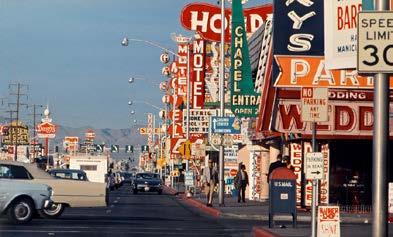
2 minute read
Learning from Las Vegas Robert Venturi 1977
Learning from Las Vegas Robert Venturi 1972
A Significance for A&P Parking Lots, or Learning from Las Vegas
Advertisement
Learning from the existing landscape is a way of being revolutionary for an architect. Not the obvious way, which is to tear down Paris and begin again, as Le Corbusier suggested in the 1920s, but another, more tolerant way; that is, to question how we look at things. The commercial strip, the Las Vegas Strip in particular—the example par excellence—challenges the architect to take a positive, non-chip-on-the shoulder view. Architects are out of the habit of looking nonjudgmentally at the environment, because orthodox Modern architecture is progressive, if not revolutionary, utopian, and puristic; it is dissatisfied with existing conditions. Modern architecture has been anything but permissive: Architects have preferred to change the existing environment rather than enhance what is there. […] Modern architects work through analogy, symbol, and image—although they have gone to lengths to disclaim almost all determinants of their forms except structural necessity and the program—and they derive insights, analogies, and stimulation from unexpected images. There is a perversity in the learning process: We look backward at history and tradition to go forward; we can also look downward to go upward. And withholding judgment may be used as a tool to make later judgment more sensitive. This is a way of learning from everything.
Denise Scott Brown, Architettura Minore on the Strip, Las Vegas, 1966.
Billboards Are Almost All Right
Architects who can accept the lessons of primitive vernacular architecture, so easy to take in an exhibit like “Architecture without Architects,” and of industrial, vernacular architecture, so easy to adapt to an electronic and space vernacular as elaborate neo-Brutalist or neo-Constructivist megastructures, do not easily acknowledge the validity of the commercial vernacular. For the artist, creating the new may mean choosing the old or the existing. Pop artists have relearned this. Our acknowledgment of existing, commercial architecture at the scale of the highway is within this tradition. Modern architecture has not so much excluded the commercial vernacular as it has tried to take it over by inventing and enforcing a vernacular of its own, improved and universal. It has rejected the combination of fine art and crude art. The Italian landscape has always harmonized the vulgar and the Vitruvian: the contorni around the duomo, the portiere’s laundry across the padrone’s portone, Supercortemaggiore against the Romanesque apse. Naked children have never played in our fountains, and I. M. Pei will never be happy on Route 66.






